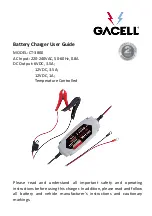
5
Tire Pressure Monitor System
TIRE PRESSURE MONITORING SYSTEM (TPMS)
For your safety, the CX-9 is equipped with TPMS that detects low tire
pressure in one or more tires. If the tire pressure starts getting low in one or
more tires, the system alerts the driver by turning on a light in the instrument
cluster (pp. 43-44) and sounding an alarm.
What to do?
Don’t ignore the TPMS warning light. Stop and check your
tire pressure (when tires are cold) and inflate them to the proper pressure.
Properly inflated tires are safer, last longer, and increase fuel economy.
In the following cases, the TPMS must be “initialized” so the system can
operate normally.
• The tire pressure is adjusted (up or down) in one or more tires.
• A tire rotation is performed.
• Any tire or wheel is replaced.
• The vehicle’s battery is disconnected, replaced or completely dead.
Initialization Process (TPMS Warning Light is Illuminated)
1
Park the vehicle in a safe place and firmly apply the parking brake.
2
Let the tires cool, then adjust the tire pressure to the specified
pressure (see tire label located on the driver’s side door jamb area) on
all four (4) tires.
3
Switch the ignition ON, but leave the vehicle parked.
4
Push and hold the TPMS “Set Switch”
(left side of dash) until the TPMS warning
light in the instrument cluster flashes
twice and a beep sound is heard once.
CAUTION:
If the TPMS “Set Switch” is pushed without adjusting the tire
pressure, the system cannot detect the normal tire pressure. The TPMS
warning light may not turn on, even if the tire pressure is low, or it may turn on
if the tire pressure is normal.
NOTE:
Drastic changes in temperature or altitude can affect the pressure in the
tires, causing the TPMS warning light to turn on. Verify the tire pressures when
driving through extreme temperature or altitude changes.
2665926_17a_Mazda_CX-9_SSG_080416.indd 5
8/4/16 11:21 PM








































